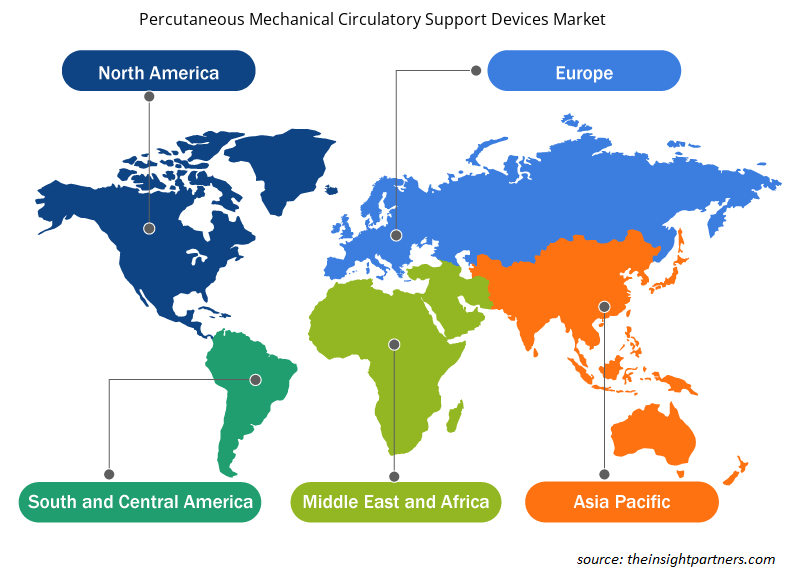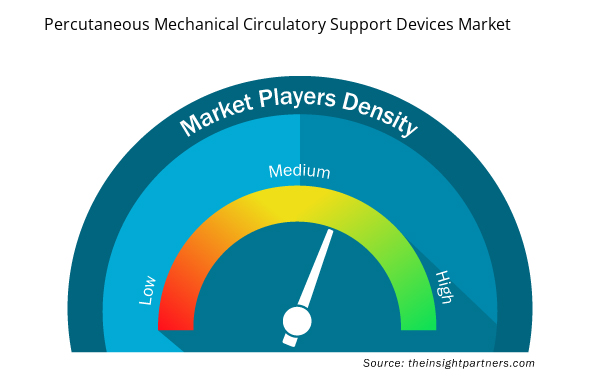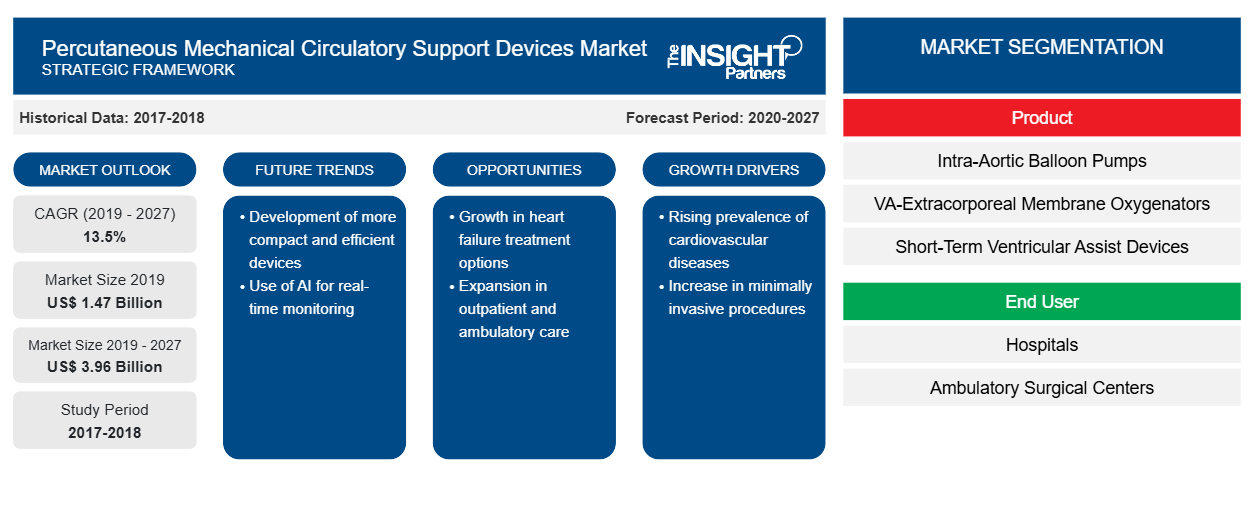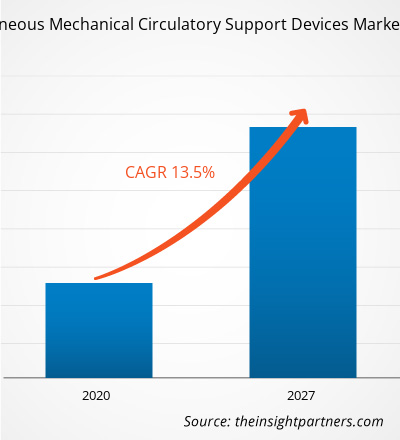Il mercato dei dispositivi di supporto circolatorio meccanico percutaneo è stato valutato a 1.474,28 milioni di dollari nel 2019 e si prevede che raggiungerà i 3.964,75 milioni di dollari entro il 2027; si prevede una crescita a un CAGR del 13,5% nel periodo 2020-2027.
I dispositivi di supporto circolatorio meccanico percutaneo offrono un approccio efficace e rapido per rallentare la spirale discendente dell'instabilità emodinamica tra i pazienti affetti da insufficienza cardiaca scompensata e shock cardiogeni finché non si percepisce una strategia più definitiva tra i pazienti per riprendersi da queste patologie cardiache. I ruoli principali dei dispositivi di supporto circolatorio meccanico percutaneo includono il miglioramento della gittata cardiaca nativa, la riduzione del volume ventricolare e delle pressioni di riempimento, l'aumento della perfusione coronarica e il mantenimento della perfusione degli organi vitali.
Approfondimenti di mercato
Aumento della popolazione geriatrica
L'elevata crescita del mercato è prevista a causa della crescente popolazione geriatrica globale. Sia nella popolazione maschile che femminile, il rischio di malattie cardiovascolari aumenta con l'avanzare dell'età. I vasi sanguigni che invecchiano sono meno flessibili, il che porta a una riduzione del flusso sanguigno. Pertanto, il rischio di malattie cardiache è elevato nella popolazione anziana. Inoltre, secondo le statistiche sulle malattie cardiache e gli ictus del 2018, l'età media al primo infarto è di 65,6 anni per gli uomini e 72,0 anni per le donne. Ha anche menzionato che l'incidenza annuale di un infarto negli Stati Uniti è di 720.000 nuovi attacchi e 335.000 attacchi ricorrenti. Inoltre, secondo i National Institutes of Health (NIH), si prevede che la popolazione americana di 65 anni e oltre raddoppierà nei prossimi tre decenni, passando da 48 milioni a 88 milioni entro il 2050. Le malattie cardiovascolari (CVD) negli americani anziani impongono un enorme onere in termini di mortalità, morbilità, disabilità, declino funzionale e costi sanitari. Uno studio retrospettivo condotto dall'Università di Pittsburgh nel 2015 afferma che la prevalenza di CVD, tra cui ipertensione, CHD, HF e ictus, aumenta di circa il 40% negli uomini e nelle donne di età compresa tra 40 e 59 anni e del 70-75% nelle persone di età compresa tra 60 e 79 anni e del 79-86% tra quelle di età pari o superiore a 80 anni. Pertanto, la crescente popolazione geriatrica che porta a maggiori rischi di insufficienza cardiaca e shock cardiogeni aumenta le applicazioni di dispositivi di supporto circolatorio meccanico percutaneo e alla fine favorisce la crescita del mercato.
Personalizza questo report in base alle tue esigenze
Riceverai la personalizzazione gratuita di qualsiasi report, comprese parti di questo report, o analisi a livello nazionale, pacchetto dati Excel, oltre a usufruire di grandi offerte e sconti per start-up e università
- Scopri le principali tendenze di mercato in questo rapporto.Questo campione GRATUITO includerà analisi di dati che spaziano dalle tendenze di mercato alle stime e alle previsioni.
Approfondimenti di mercato basati sui prodotti
Il segmento di prodotto del mercato dei dispositivi di supporto circolatorio meccanico percutaneo è suddiviso in pompe a palloncino intra-aortiche, ossigenazione extracorporea a membrana VA e dispositivi di assistenza ventricolare a breve termine. Il segmento delle pompe a palloncino intra-aortiche ha detenuto la quota maggiore del mercato dei dispositivi di supporto circolatorio meccanico percutaneo nel 2019. Si prevede che il segmento dei dispositivi di assistenza ventricolare a breve termine crescerà a un CAGR del 14,0% durante il periodo di previsione.
Approfondimenti di mercato basati sull'utente finale
Il segmento di utenti finali del mercato dei dispositivi di supporto circolatorio meccanico percutaneo è suddiviso in ospedali, centri chirurgici ambulatoriali e altri. Il segmento degli ospedali ha detenuto la quota maggiore del mercato dei dispositivi di supporto circolatorio meccanico percutaneo nel 2019. Si prevede inoltre che il segmento crescerà a un CAGR del 14,2% durante il periodo di previsione.
Le aziende adottano comunemente strategie di lancio e approvazione dei prodotti per espandere la propria presenza e il proprio portafoglio prodotti in tutto il mondo e soddisfare la crescente domanda.
Inoltre, gli operatori di mercato che operano nel mercato dei dispositivi di supporto circolatorio meccanico percutaneo adottano la strategia di espansione per ampliare la base clienti in tutto il mondo, il che consente agli operatori di mantenere il loro marchio a livello globale. Ad esempio, a giugno 2016, Medetronic ha lanciato un prodotto, Beacon, un servizio di gestione dell'assistenza per pazienti con insufficienza cardiaca ad alto rischio. Questo servizio combina i dati dei dispositivi Medtronic per defibrillazione cardioverter impiantabile (ICD) o terapia di resincronizzazione cardiaca (CRT) con monitoraggio post-acuto da MCMS.
Approfondimenti regionali sul mercato dei dispositivi di supporto circolatorio meccanico percutaneo
Le tendenze regionali e i fattori che influenzano il mercato dei dispositivi di supporto circolatorio meccanico percutaneo durante il periodo di previsione sono stati ampiamente spiegati dagli analisti di Insight Partners. Questa sezione discute anche i segmenti di mercato dei dispositivi di supporto circolatorio meccanico percutaneo e la geografia in Nord America, Europa, Asia Pacifico, Medio Oriente e Africa e Sud e Centro America.

- Ottieni i dati specifici regionali per il mercato dei dispositivi di supporto circolatorio meccanico percutaneo
Ambito del rapporto di mercato sui dispositivi di supporto circolatorio meccanico percutaneo
| Attributo del report | Dettagli |
|---|---|
| Dimensioni del mercato nel 2019 | 1,47 miliardi di dollari USA |
| Dimensioni del mercato entro il 2027 | 3,96 miliardi di dollari USA |
| CAGR globale (2019 - 2027) | 13,5% |
| Dati storici | 2017-2018 |
| Periodo di previsione | 2020-2027 |
| Segmenti coperti | Per Prodotto
|
| Regioni e Paesi coperti | America del Nord
|
| Leader di mercato e profili aziendali chiave |
|
Densità degli attori del mercato: comprendere il suo impatto sulle dinamiche aziendali
Il mercato dei dispositivi di supporto circolatorio meccanico percutaneo sta crescendo rapidamente, spinto dalla crescente domanda degli utenti finali dovuta a fattori quali l'evoluzione delle preferenze dei consumatori, i progressi tecnologici e una maggiore consapevolezza dei benefici del prodotto. Con l'aumento della domanda, le aziende stanno ampliando la propria offerta, innovando per soddisfare le esigenze dei consumatori e capitalizzando sulle tendenze emergenti, il che alimenta ulteriormente la crescita del mercato.
La densità degli operatori di mercato si riferisce alla distribuzione di aziende o società che operano in un particolare mercato o settore. Indica quanti concorrenti (operatori di mercato) sono presenti in un dato spazio di mercato in relazione alle sue dimensioni o al valore di mercato totale.
Le principali aziende che operano nel mercato dei dispositivi di supporto circolatorio meccanico percutaneo sono:
- Abate.
- Medtronic
- Azienda
- Teleflex Incorporata
- Livanova Plc (Cardiacassist, Inc.).
Disclaimer : le aziende elencate sopra non sono classificate secondo un ordine particolare.

- Ottieni la panoramica dei principali attori del mercato dei dispositivi di supporto circolatorio meccanico percutaneo
Mercato globale dei dispositivi di supporto circolatorio meccanico percutaneo – ByProduct
- Pompe a palloncino intra-aortiche
- VA-Ossigenazione extracorporea a membrana (ECMO)
- Ossigenatori
- Dispositivi di assistenza ventricolare a breve termine (VAD)
- Impella
- Cuore in tandem
Mercato globale dei dispositivi di supporto circolatorio meccanico percutaneo – Di EndUser
- Ospedali
- Centri chirurgici ambulatoriali
- Altri
Dispositivi di supporto circolatorio meccanico percutaneo globale - Per area geografica
America del Nord
- NOI
- Canada
- Messico
Europa
- Francia
- Germania
- Italia
- Regno Unito
- Spagna
- Resto d'Europa
Asia Pacifico (APAC)
- Cina
- India
- Corea del Sud
- Giappone
- Australia
- Resto dell'APAC
Medio Oriente e Africa (MEA)
- Sudafrica
- Arabia Saudita
- Emirati Arabi Uniti
- Resto del MEA
America del Sud (SAM)
- Brasile
- Argentina
- Resto del SAM
Profili aziendali
- Abate.
- Medtronic
- Azienda
- Teleflex Incorporata
- LivanovaPlc (Cardiacassist, Inc.).
- Abiomed
- Euroset
- Cuore di Berlino
- Azienda
- CardioBridge GmbH
- Analisi storica (2 anni), anno base, previsione (7 anni) con CAGR
- Analisi PEST e SWOT
- Valore/volume delle dimensioni del mercato - Globale, regionale, nazionale
- Industria e panorama competitivo
- Set di dati Excel



Report Coverage
Revenue forecast, Company Analysis, Industry landscape, Growth factors, and Trends

Segment Covered
This text is related
to segments covered.

Regional Scope
North America, Europe, Asia Pacific, Middle East & Africa, South & Central America

Country Scope
This text is related
to country scope.
Domande frequenti
The North American region holds the largest market for the breast cancer screening. The United States held the largest market for percutaneous mechanical circulatory support devices market and is expected to grow due to factors such as increasing number ofincreasing prevalence of cardiovascular diseases & heart failures, growing developments for screening and imaging process by the companies and others.
The growth of the market is attributed to some key driving factors such as rising geriatric population, increasing prevalence of cardiovascular diseases & heart failures however, impact of COVID-19 pandemic on medical device industry and high cost of products and procedures is expected to restraint the growth of the market during the forecast years.
The percutaneous mechanical circulatory support devices market is highly competitive in nature with considerable number of players, having a high level of consolidation overall revenue share. Most of the companies operating in the percutaneous mechanical circulatory support devices market are present globally and have wide distribution and sales network through partnerships or authorized dealers.
Trends and growth analysis reports related to Life Sciences : READ MORE..
The List of Companies - Percutaneous Mechanical Circulatory Support Devices Market
- Abbott.
- Medtronic
- Getinge AB
- Teleflex Incorporated
- Livanova Plc (Cardiacassist, Inc.).
- Abiomed
- Eurosets
- Berlin Heart
- Jarvik Heart, Inc.
- CardioBridge GmbH
The Insight Partners performs research in 4 major stages: Data Collection & Secondary Research, Primary Research, Data Analysis and Data Triangulation & Final Review.
- Data Collection and Secondary Research:
As a market research and consulting firm operating from a decade, we have published and advised several client across the globe. First step for any study will start with an assessment of currently available data and insights from existing reports. Further, historical and current market information is collected from Investor Presentations, Annual Reports, SEC Filings, etc., and other information related to company’s performance and market positioning are gathered from Paid Databases (Factiva, Hoovers, and Reuters) and various other publications available in public domain.
Several associations trade associates, technical forums, institutes, societies and organization are accessed to gain technical as well as market related insights through their publications such as research papers, blogs and press releases related to the studies are referred to get cues about the market. Further, white papers, journals, magazines, and other news articles published in last 3 years are scrutinized and analyzed to understand the current market trends.
- Primary Research:
The primarily interview analysis comprise of data obtained from industry participants interview and answers to survey questions gathered by in-house primary team.
For primary research, interviews are conducted with industry experts/CEOs/Marketing Managers/VPs/Subject Matter Experts from both demand and supply side to get a 360-degree view of the market. The primary team conducts several interviews based on the complexity of the markets to understand the various market trends and dynamics which makes research more credible and precise.
A typical research interview fulfils the following functions:
- Provides first-hand information on the market size, market trends, growth trends, competitive landscape, and outlook
- Validates and strengthens in-house secondary research findings
- Develops the analysis team’s expertise and market understanding
Primary research involves email interactions and telephone interviews for each market, category, segment, and sub-segment across geographies. The participants who typically take part in such a process include, but are not limited to:
- Industry participants: VPs, business development managers, market intelligence managers and national sales managers
- Outside experts: Valuation experts, research analysts and key opinion leaders specializing in the electronics and semiconductor industry.
Below is the breakup of our primary respondents by company, designation, and region:

Once we receive the confirmation from primary research sources or primary respondents, we finalize the base year market estimation and forecast the data as per the macroeconomic and microeconomic factors assessed during data collection.
- Data Analysis:
Once data is validated through both secondary as well as primary respondents, we finalize the market estimations by hypothesis formulation and factor analysis at regional and country level.
- Macro-Economic Factor Analysis:
We analyse macroeconomic indicators such the gross domestic product (GDP), increase in the demand for goods and services across industries, technological advancement, regional economic growth, governmental policies, the influence of COVID-19, PEST analysis, and other aspects. This analysis aids in setting benchmarks for various nations/regions and approximating market splits. Additionally, the general trend of the aforementioned components aid in determining the market's development possibilities.
- Country Level Data:
Various factors that are especially aligned to the country are taken into account to determine the market size for a certain area and country, including the presence of vendors, such as headquarters and offices, the country's GDP, demand patterns, and industry growth. To comprehend the market dynamics for the nation, a number of growth variables, inhibitors, application areas, and current market trends are researched. The aforementioned elements aid in determining the country's overall market's growth potential.
- Company Profile:
The “Table of Contents” is formulated by listing and analyzing more than 25 - 30 companies operating in the market ecosystem across geographies. However, we profile only 10 companies as a standard practice in our syndicate reports. These 10 companies comprise leading, emerging, and regional players. Nonetheless, our analysis is not restricted to the 10 listed companies, we also analyze other companies present in the market to develop a holistic view and understand the prevailing trends. The “Company Profiles” section in the report covers key facts, business description, products & services, financial information, SWOT analysis, and key developments. The financial information presented is extracted from the annual reports and official documents of the publicly listed companies. Upon collecting the information for the sections of respective companies, we verify them via various primary sources and then compile the data in respective company profiles. The company level information helps us in deriving the base number as well as in forecasting the market size.
- Developing Base Number:
Aggregation of sales statistics (2020-2022) and macro-economic factor, and other secondary and primary research insights are utilized to arrive at base number and related market shares for 2022. The data gaps are identified in this step and relevant market data is analyzed, collected from paid primary interviews or databases. On finalizing the base year market size, forecasts are developed on the basis of macro-economic, industry and market growth factors and company level analysis.
- Data Triangulation and Final Review:
The market findings and base year market size calculations are validated from supply as well as demand side. Demand side validations are based on macro-economic factor analysis and benchmarks for respective regions and countries. In case of supply side validations, revenues of major companies are estimated (in case not available) based on industry benchmark, approximate number of employees, product portfolio, and primary interviews revenues are gathered. Further revenue from target product/service segment is assessed to avoid overshooting of market statistics. In case of heavy deviations between supply and demand side values, all thes steps are repeated to achieve synchronization.
We follow an iterative model, wherein we share our research findings with Subject Matter Experts (SME’s) and Key Opinion Leaders (KOLs) until consensus view of the market is not formulated – this model negates any drastic deviation in the opinions of experts. Only validated and universally acceptable research findings are quoted in our reports.
We have important check points that we use to validate our research findings – which we call – data triangulation, where we validate the information, we generate from secondary sources with primary interviews and then we re-validate with our internal data bases and Subject matter experts. This comprehensive model enables us to deliver high quality, reliable data in shortest possible time.


 Ottieni un campione gratuito per questo repot
Ottieni un campione gratuito per questo repot